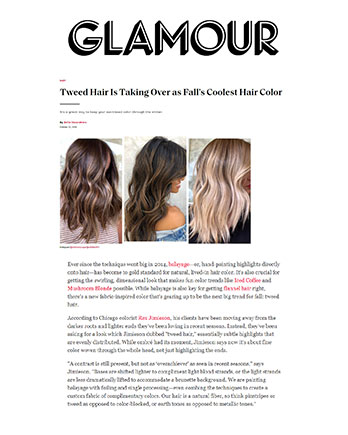Glamour October 22, 2019
 Glamour
Glamour
Hair
Tweed Hair Is Taking Over as Fall’s Coolest Hair Color
It's a great way to keep your sun-kissed color through the winter.
Ever since the technique went big in 2014, balayage—or hand-painting highlights directly onto hair—has become the gold standard for natural, lived-in hair color. It's also crucial for getting the swirling, dimensional look that makes fun color trends like Iced Coffee and Mushroom Blonde possible. While balayage is also key for getting flannel hair right, there's a new fabric-inspired color that's gearing up to be the next big trend for fall: tweed hair.
According to Chicago colorist Rex Jimieson, his clients have been moving away from the darker roots and lighter ends they've been loving in recent seasons. Instead, they've been asking for a look which Jimieson dubbed "tweed hair," essentially subtle highlights that are evenly distributed. While ombré had its moment, Jimieson says now it's about fine color woven through the whole head, not just highlighting the ends.
"A contrast is still present, but not as ‘overachiever’ as seen in recent seasons," says Jimieson. "Bases are shifted lighter to compliment light blond strands, or the light strands are less dramatically lifted to accommodate a brunette background. We are painting balayage with foiling and single processing—even combining the techniques to create a custom fabric of complimentary colors. Our hair is a natural fiber, so think pinstripes or tweed as opposed to color-blocked, or earth tones as opposed to metallic tones.”
While it has a similar vibe to flannel hair, there are subtle differences. “Tweed uses smaller sections and exposes the natural undertones in your hair rather than removing them completely," says Jimieson. "Flannel is more edgy, while tweed is more sophisticated. If your hair doesn’t have a lot of color buildup, bleach may not even be needed to achieve the dimension and subtlety of tweed.”
Jimieson recommends the technique for people who want a more natural tone that's still dimensional, as the contrast between the base and lightness isn't so extreme. If you want to try the shade, ask the stylist to unify your color and start your highlights close to the roots instead of midway down your hair. The two key things to getting the trend right is a very subtle shade difference between your base and highlights, and making sure the highlights are fine to get that sophisticated look. And as always, Jimieson stresses the importance of coming with plenty of examples so you can get what you really want.
For your convenience, we pulled some of our favorite examples, below. Now all you have to do is call your salon.
